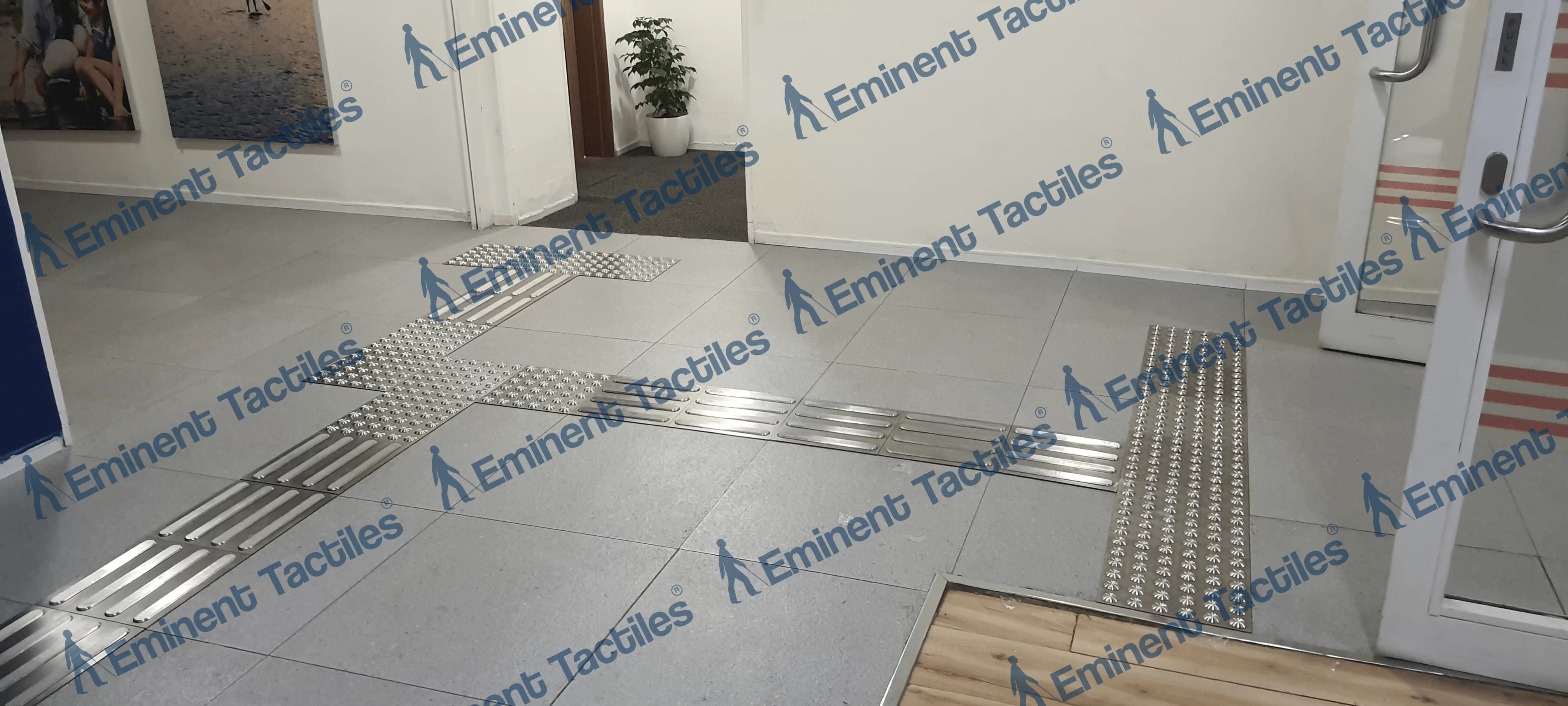
In today’s world, making places easy for everyone to use is very important. One smart way to help people move around is by using tactile directional strips. These strips have bumps or patterns that people can feel under their feet, helping those who can’t see well know where to go. They can feel these strips with a cane or just by walking, which helps them move around safely without needing to see.
These strips are an important part of making places friendly for everyone. When we put these strips in public places, it shows we care about including everyone, no matter their abilities. This article talks about how these strips help people who can’t see and where they are needed the most. Understanding how important these strips are helps city planners and business owners make places that are safe and welcoming for everyone.
Understanding Tactile Directional Strips
Tactile directional strips, integral to the design of accessible public spaces, serve as navigational aids that guide visually impaired individuals through tactile feedback. These features are a subset of tactile paving, which encompasses various ground surface indicators providing physical cues detectable by foot or cane. Understanding the nuances of tactile paving, including its types, materials, and design considerations, is crucial for implementing effective guidance systems.
Where Tactile Directional Strips Are Required
Tactile directional strips are a vital component of accessible design, guiding visually impaired individuals safely through various environments. Their deployment in specific areas not only enhances navigability but also underscores a commitment to inclusivity. This section outlines the key locations where tactile strips are essential, spanning from bustling public transportation hubs to serene urban infrastructures and critical public buildings.
Public Transportation Hubs
Public transportation systems are the lifelines of urban mobility, making their accessibility crucial for all individuals, including those with visual impairments. Tactile directional strips play a significant role in these environments by providing guidance and ensuring safety.
- Train Stations and Platforms: Strips guide users towards ticket booths, platforms, and exits while warning surfaces alert them to the edge of platforms.
- Bus Terminals: Directional guidance is crucial for navigating to different bus bays, waiting areas, and service counters.
- Airports: Given their vast size and complexity, airports benefit significantly from tactile strips, helping users navigate from check-in counters to gates, restrooms, and baggage claim areas.
Urban Infrastructure
The urban landscape is dotted with various public spaces that must be accessible to everyone. Tactile directional strips in these areas ensure that visually impaired individuals can move safely and independently.
- Pedestrian Crossings: Tactile strips at crossings alert users to the edge of sidewalks and guide them across streets safely.
- Public Squares and Parks: These recreational areas use tactile paths to guide visitors through entrances, paths, and around significant features or attractions.
- Sidewalks and Footpaths: Strategic placement of tactile paving helps in navigating around urban obstacles, intersections, and public amenities.
Public Buildings and Facilities
Public buildings and facilities are focal points for community activities and services, making their accessibility paramount. Tactile directional strips facilitate navigation within these spaces, enhancing the user experience for visually impaired visitors.
- Government Buildings: These include city halls, courthouses, and municipal facilities, where tactile strips guide visitors to essential services and offices.
- Educational Institutions: Schools, colleges, and universities use tactile paving to assist students and staff in navigating campus buildings and outdoor spaces.
- Hospitals and Healthcare Centers: In environments where timely access is critical, tactile strips guide patients and visitors through entrances, corridors, and various departments.
- Shopping Malls and Commercial Complexes: These bustling centres use tactile guidance to help shoppers navigate from parking areas to stores, restrooms, and service counters.
Design and Implementation
The design and implementation of tactile directional strips require meticulous planning, consideration of materials, and thoughtful integration with existing infrastructure to achieve maximum efficacy. This section delves into the key aspects of this process and highlights successful global implementations that serve as benchmarks for future projects.
Planning and Layout Considerations for Maximum Efficacy
Effective tactile paving design begins with a thorough understanding of the environment and the needs of its users. Planners must consider:
- User Flow: Understanding the movement patterns of pedestrians, especially those visually impaired, is crucial. Tactile strips should guide users along the most direct and safe paths, avoiding potential hazards.
- Environmental Context: The layout must account for the environment’s specific characteristics, such as climate, urban density, and the presence of existing pedestrian infrastructure.
- Regulatory Compliance: Adhering to local and international accessibility standards ensures that the implementation of tactile strips meets legal requirements and best practices.
Choosing the Right Materials for Durability and Visibility
Material selection is pivotal to the longevity and effectiveness of tactile directional strips. Considerations include:
- Durability: Materials should withstand environmental wear and tear, including extreme weather, heavy foot traffic, and cleaning processes.
- Sensory Contrast: Materials must provide a tactile contrast to surrounding surfaces, ensuring they are easily detectable by cane or underfoot.
- Visual Contrast: For individuals with partial sight, materials should offer visual contrast against the surrounding area, aiding in navigation.
Conclusion
Tactile directional strips represent a critical component in the broader mission to create accessible, inclusive public spaces. This guide has traversed the importance of these strips, from aiding visually impaired individuals to navigate complex urban environments independently, to serving as a testament to societal commitment towards inclusivity. The implementation of tactile guidance systems underscores a universal design principle that benefits all users by promoting safer and more navigable public spaces.
Tactile directional strips are textured ground surface indicators that guide visually impaired people by providing tactile feedback underfoot or with a cane.
They improve accessibility, enhance safety, and allow visually impaired individuals to navigate public spaces such as stations, sidewalks, and buildings independently.
They are installed in public transport hubs, pedestrian crossings, sidewalks, parks, shopping malls, hospitals, government offices, and schools to ensure safe navigation.
Common materials include polyurethane, stainless steel, ceramic, and concrete. The choice depends on durability, visibility, and environmental conditions.
Yes. They are designed according to international standards such as ADA (Americans with Disabilities Act) and ISO guidelines to ensure safety and usability.
Yes. Manufacturers like Eminent Tactiles offer custom sizes, colours, and materials to match the surrounding design while maintaining high safety and accessibility standards.
Regular inspection and cleaning are essential. Damaged or worn strips should be replaced immediately to preserve tactile contrast and ensure continued safety and compliance.
Stainless steel and polyurethane (PU) tactile strips are best for outdoor environments due to their weather resistance, durability, and strong anti-slip properties.

offer now at
Our Clients





































